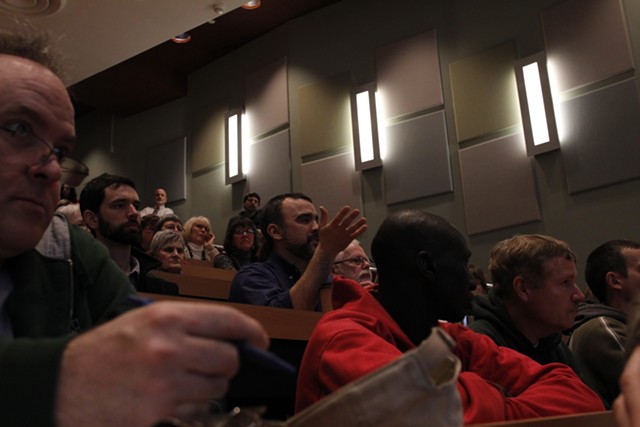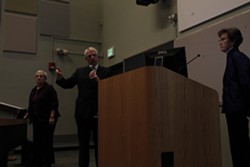
- Charles Eichacker
- University of Vermont employees discuss cost-sharing plan.
On Thursday morning, a couple hundred University of Vermont employees packed Carpenter Auditorium to express their concerns about potential increases in the amount they pay for benefits.
UVM currently offers health care and retirement benefits to faculty and staff, as well as tuition remissions for their children and other dependents. But to make up for lower revenues and increasing costs, the administration is considering shifting some of the cost of those benefits to the employees. The plan,
known as “cost sharing,” would take effect July 1, 2014.
“There’s a pretty significant gap that we had to address,” UVM Vice President for Finance and Treasurer Richard Cate said at the outset of the town-hall-style meeting (which was preceded by a similar forum on Monday). “Some people favor tuition remission more, some favor health insurance more, but in no case is this about having a benefit going away.” The college hasn't made any decisions yet about adjusting benefits, Cate added, and is accepting feedback during the month of February.
Jan Carney, an associate dean in the UVM College of Medicine and chair of the University Benefits Advisory Council, then provided some background on the cost-sharing plan and put a question to the employees: Which benefits could be adjusted that would have the least — and most — negative impact on them?
In response, about 20 employees spoke into microphones that were passed around the room. Some identified individual benefits. Others refused to indicate a preference and expressed frustration about what they perceived as an unfair distribution of the costs.
“You’re asking us to determine negative impacts in aggregate, on an individual basis, and it makes no sense. I’ve used all these benefits over the years, some to a great degree,” said William Valliere, a research specialist in the Rubenstein School of Environment and Natural Resources. "My daughter graduates from this institution this year. I would never have been able to send her here otherwise. I just had a hip replaced last year, and would not have been able to afford that."

- Charles Eichacker
- Richard Cate speaks to UVM employees.
“Any cuts would have a negative impact on me,” said Helen Maciejewski, an administrative coordinator in the Department of Animal Science. “In any management course I’ve ever taken, a good organization’s cuts start at the top. Many departments … are working hard to increase revenues, to keep our students in seats, and we all face challenges that come down from central administration in doing that. I would like to see central administration take the lead in cuts.”
Several other speakers issued similar requests that the university’s leadership absorb more of the blow. In part, those comments may have stemmed from a recent analysis by United Academics, UVM’s faculty union, of
employee salary data from 2003 to 2012. That study found the average UVM administrator's salary to have increased by 53 percent in that time, outpacing a UVM-wide pay increase of 39 percent, as well as growth in student enrollment.
Cate did not respond to the suggestions that the administration take the lead in cuts, but he did clarify at the beginning of the meeting that the cost-sharing plan was not an attempt to balance the budget “on the backs of the employees … 90 percent of what we’re doing to address the budget has nothing to do with benefits or compensation in any way. A lot of it is in terms of revenue generation, tuition increases, an expanded international program, more distance education.” Cate also mentioned that the increased benefits costs would be offset by salary increases for some employees.
Another concern expressed by the employees, however, had to do with their already-low salaries, which they said they accepted based on the benefits it would allow them to receive. “Many of us need second jobs just to have a livable wage in Vermont. Some of us qualify for state assistance,” said Valerie Carzello, who works in the school’s libraries. “You cut these benefits, there’s no incentive to stay, and you’re going to lose good people.”
Another assurance Cate gave at the beginning of the meeting was that “many employees” need not worry about “the university ... arbitrarily [doing] something” to their benefits, since the school is going through collective bargaining with the various unions on campus. But not all UVM employees belong to a union, and in light of the cost-sharing proposal, there is now an effort to change that. After the meeting, representatives of the Vermont State Employees’ Association were handing out information.

- Charles Eichacker
- Valerie Carzello addresses the University Benefits Advisory Council.
“VSEA is now actively trying to organize UVM’s clerical, technical and specialized staff,” VSEA communications coordinator Doug Gibson wrote in an email. “These are the employees who, right now, have no recourse to combat the ‘cost-sharing’ measures being proposed.”
That union push parallels one
currently underway by employees of Sodexo, the company that handles dining services for UVM and the Vermont state colleges.
In an interview after the meeting, Carzello explained that she is very interested in joining a union, but is still “shopping around” for the right one.













Comments
Showing 1-1 of 1
Comments are closed.
From 2014-2020, Seven Days allowed readers to comment on all stories posted on our website. While we've appreciated the suggestions and insights, right now Seven Days is prioritizing our core mission — producing high-quality, responsible local journalism — over moderating online debates between readers.
To criticize, correct or praise our reporting, please send us a letter to the editor or send us a tip. We’ll check it out and report the results.
Online comments may return when we have better tech tools for managing them. Thanks for reading.